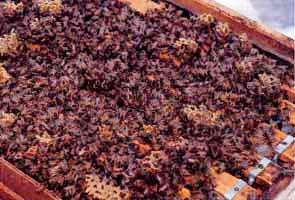|
We are now well into autumn and a cold winter wind will soon begin to blow. It is quite silent now at the bee farm that was once lively with buzzing of the bees and joyful shouts of the children in the summer. Soon, it will be time to look back upon the passing year.
In the world of "agriculture," the same work is repeated at about the same time of the year. But, since it is all at the mercy of the weather, the work is not exactly the same every year. We pass each year keeping a close watch on the conditions in the villages surrounding the bee farm and the trees and flowering plants in the plains. Through it all we experience in seemingly quick alternation elation and disappointment regarding the flowering conditions.
This summer was a hot one, with the period of lingering summer heat protracted. Honeybees are also active during such years, and the fruit trees and village trees that were useful for pollination from spring to summer yielded a good harvest on the whole for this year.
We have just moved the beehives to the southern bee farm, where it is warmer, so that the bees can pass the winter there. In the beehive, the queen bee stops laying eggs and so the number of honeybees is reduced to less than 1/3 of that in the peak period. On a warm day, you can see honeybees flying out of the beehive, but drones that do nothing but breed have already been driven out and now not a single drone remains in the beehive. The season for laying eggs has come to an end. Now, only worker bees that grew up in the autumn and the queen bee start to pass the winter in the hive until the plum blossoms start to bloom. During this period the bees will eat their stored honey and pollen. These last surviving worker bees of this year not only do the work of collecting pollen and honey for passing the winter, but also have an important mission of passing the "life" of the swarm on to the next generation by silently huddling together to make it through the severe winter.
 |
As beekeepers, we need to work with the honeybees to ensure that they are able to pass the winter safely. Beehives that have been stacked as high as two or three tiers are no longer piled to reduce the area in which the bees reside. This is so that the bees can keep themselves warm by gathering close together. The beehive entrance is also narrowed to about 1/3 its size to keep the cold out. In addition, we cover the beehives with a vinyl cover to keep out the draft, completing the preparations for passing the winter. If we leave the empty beehives and honeycomb plates as they are, the honeycomb plates will be crumbled to pieces by the larvae of Galleria mellonella that eat the beeswax, which is the material the bees use to make honeycombs.
Thus, we clean the inside of the beehive by burning with a gas burner, and clean and store the honeycomb plates after fumigating them with gas. The paint on the exterior of the beehives damaged by the wind and rain and what has been destroyed must also be repaired at this time. When the work for this year comes to an end, the preparations for the next year's work begin.
|





